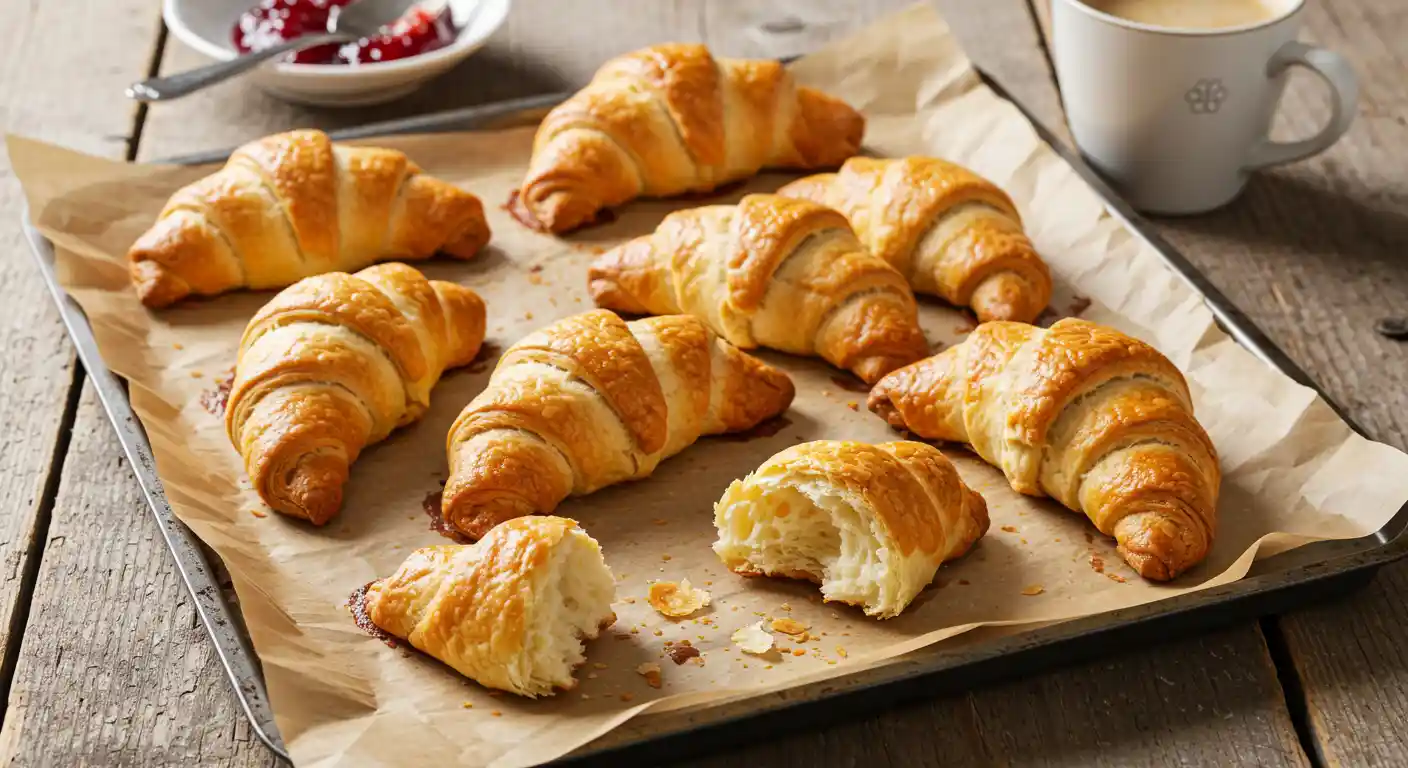If you love flaky pastries with a light, airy texture, this Swiss Gipfeli recipe is for you. Gipfeli, often referred to as a Swiss croissant, shares similarities with the classic French croissant but has a slightly denser texture and less buttery layers. These crescent-shaped pastries are a breakfast staple in Switzerland, enjoyed plain or filled with chocolate, almond paste, or jam.
Unlike traditional French croissants, Gipfeli is made with a more straightforward laminated dough that is easier to work with, making it perfect for home bakers. The dough is folded with cold butter to create flaky layers, while the light sweetness makes it ideal for both sweet and savory variations.
Table of Contents
Why You’ll Love This Recipe
Making Gipfeli at home is more than just a fun baking project—it’s a chance to enjoy fresh, flaky pastries straight from your own kitchen. Here’s why this homemade Gipfeli recipe is worth trying:
1. Easier Than Traditional Croissants
Unlike French croissants, which require extensive laminating and folding, this Swiss Gipfeli recipe is more beginner-friendly. The slightly denser texture makes the process less delicate, so you can achieve flaky layers without complicated techniques.
2. Buttery, Yet Light and Flaky
Though Gipfeli contains less butter than a French croissant, it still delivers a delightfully crisp outer layer with a soft, airy inside. The rolling and folding process ensures the dough develops its signature flaky texture.
3. Perfect for Sweet or Savory Fillings
While Gipfeli is delicious on its own, it also pairs well with a variety of fillings. You can enjoy it:
- Sweet: Filled with chocolate, almond paste, or jam
- Savory: Stuffed with cheese, or herbs
4. Freshly Baked Goodness Anytime
Nothing beats the aroma of freshly baked Gipfeli straight from the oven. Making it at home lets you control the ingredients, ensuring you get high-quality, preservative-free pastries whenever you crave them.
5. A Swiss Breakfast Staple
In Swiss baking, Gipfeli is a classic enjoyed with coffee or hot chocolate. Learning to make it means you can bring a taste of Switzerland to your breakfast table—without a trip to the bakery.
Now that you know why this recipe is perfect, let’s look at the ingredients you’ll need to make your own flaky Gipfeli.
Ingredients
To make homemade Gipfeli, you’ll need a combination of basic pantry staples and a few key ingredients to achieve the perfect flaky texture. Using cold butter and following the right folding technique will help create light, airy layers in this Swiss pastry.

For the Dough:
- 4 cups all-purpose flour (or bread flour for extra chewiness)
- 2 ¼ teaspoons instant yeast (or active dry yeast, dissolved in warm milk)
- 1 cup warm milk (about 110°F)
- ¼ cup granulated sugar
- 1 teaspoon salt
- 1 large egg
- 2 tablespoons unsalted butter, softened
For the Butter Layer (Laminating):
- 1 cup cold butter, cut into thin slices
- 2 tablespoons flour (to prevent sticking while rolling and folding)
For the Egg Wash:
- 1 large egg yolk
- 1 tablespoon milk
Optional Fillings:
- Sweet Fillings: Chocolate, almond paste, fruit jam
- Savory Fillings: Cheese, herbs
Instructions
Follow these step-by-step directions to make light, flaky Swiss Gipfeli at home. This process involves preparing the dough, laminating with cold butter, shaping, and baking until golden brown.
Step 1: Prepare the Dough
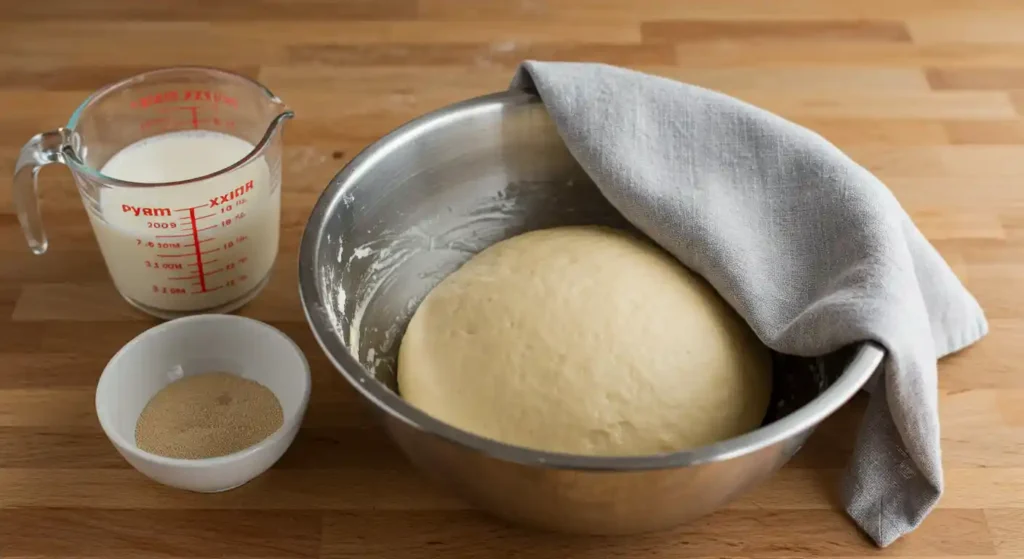
- If using active dry yeast, mix it with warm milk in a small bowl and let it sit for 5 minutes until foamy. If you’re using instant yeast, you can simply add it directly to the dry ingredients without activating it first.
- In a large mixing bowl, combine flour, sugar, and salt, stirring to distribute evenly.
- Add the softened butter, egg, and yeast mixture, then mix until the dough begins to come together.
- Transfer to a lightly floured surface and knead for 8–10 minutes until smooth and elastic.
- Place the dough in a greased bowl, cover with plastic wrap, and let it rest in a warm place for about 1 hour, or until it doubles in size.
Step 2: Laminate the Dough (Rolling and Folding)
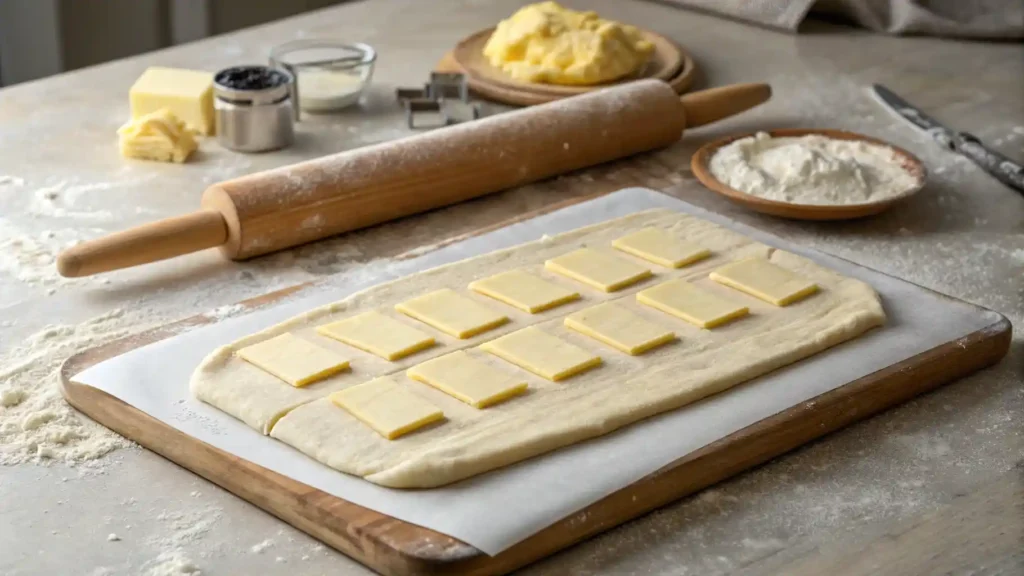
- Roll the dough into a ¼-inch thick rectangle on a floured surface.
- Evenly distribute the cold butter slices over two-thirds of the dough.
- Fold the unbuttered third over the middle, then fold the remaining third over the top, creating a letter-fold shape.
- Rotate the dough 90 degrees, roll it out again into a rectangle, and fold the same way.
- Wrap the dough in plastic wrap and refrigerate for 30 minutes to keep the butter cold.
Step 3: Roll and Cut the Dough
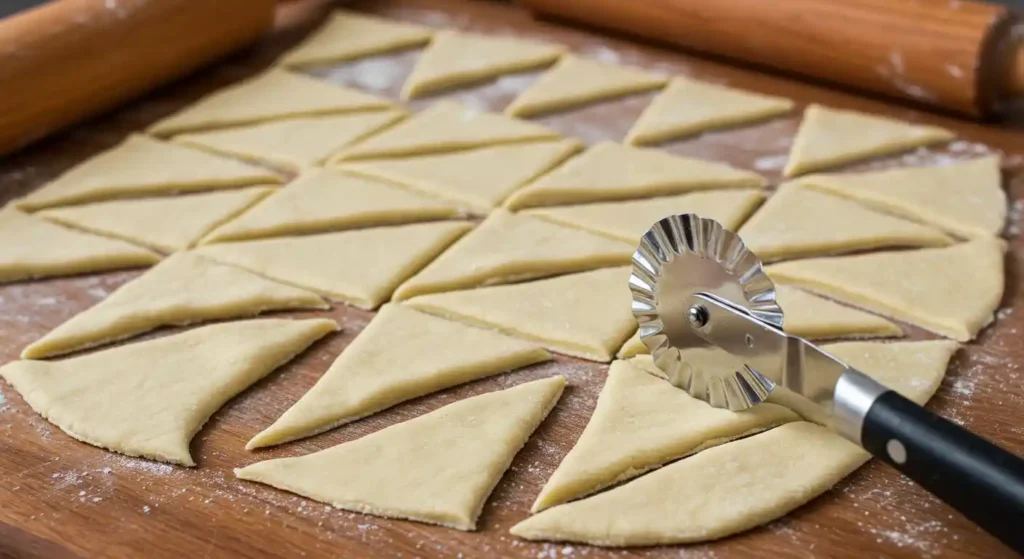
- Roll out the chilled dough into a large ¼-inch thick rectangle.
- Using a sharp knife or pastry cutter, cut the dough into long triangles with a 2-inch base.
- If adding a filling, place a small amount at the base of each triangle before rolling.
Step 4: Shape the Gipfeli
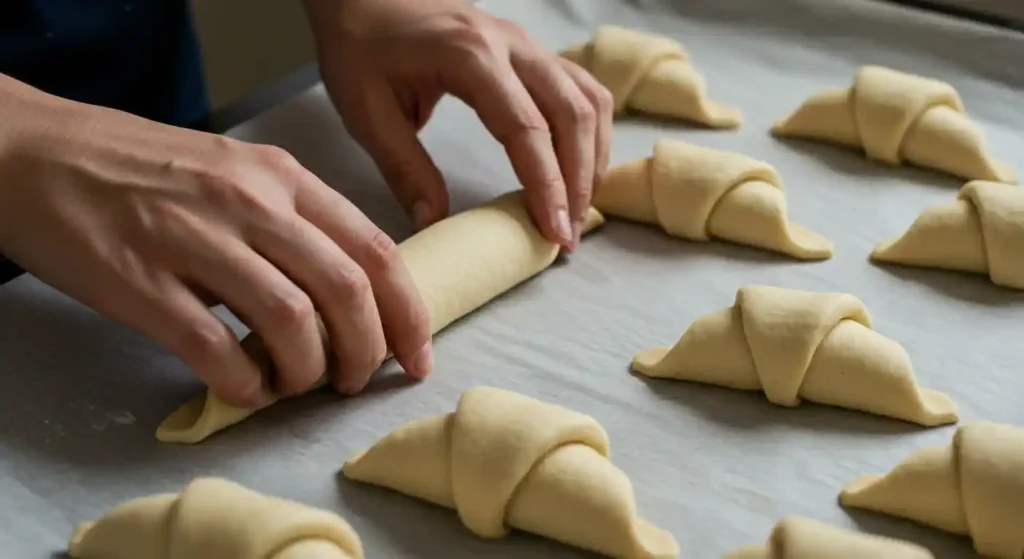
- Starting at the wide base, roll each triangle towards the tip to form a crescent shape.
- Arrange the shaped Gipfeli on a parchment-lined baking sheet, leaving space between each one.
- Loosely cover and allow them to proof for 30 minutes, until slightly puffed.
Step 5: Bake to Perfection
- Preheat the oven to 350°F (180°C).
- Whisk egg yolk and milk for egg wash
- Lightly brush the Gipfeli with egg wash for a shiny, golden crust.
- Bake for 15–20 minutes, or until the pastries are golden brown and have a light, crisp texture.
- Take the dish out of the oven and let it cool completely on a wire rack.
Your homemade Swiss Gipfeli is now ready to enjoy! Serve warm with jam, honey, or a dusting of powdered sugar. For more ways to enhance and customize your Gipfeli, check out the pro tips and variations next.
Pro Tips and Variations
Mastering homemade Gipfeli is easier with the right techniques. Here are some expert tips and creative variations to help you achieve the perfect flaky pastry every time.
Pro Tips for Perfect Gipfeli
Use Cold Butter for Flaky Layers
- To achieve the signature flaky texture, make sure your butter is cold when layering. This helps create thin, crisp layers in the laminated dough.
Don’t Overwork the Dough
- Handle the dough gently when rolling and folding. Overworking can cause it to become dense rather than light and airy.
Chill Between Each Fold
- Refrigerating the dough for 30 minutes between folds prevents the butter from melting, making it easier to roll and shape.
Use a Sharp Knife for Cutting
- When cutting the dough into triangles, use a sharp knife or pastry cutter for clean edges, which helps the layers rise properly.
Proof in a Warm Place
- Let the shaped Gipfeli rise in a warm place for at least 30 minutes before baking. This allows the yeast to develop air pockets, resulting in a lighter texture.
Brush with Egg Wash for a Golden Crust
- A light egg wash before baking gives the Gipfeli a shiny, golden brown finish.
Delicious Variations
Chocolate-Filled Gipfeli (Schoggigipfel)
- Add a small piece of dark chocolate or chocolate spread at the base of each triangle before rolling.
Almond Croissant-Style (Mandelgipfel)
- Fill the Gipfeli with almond paste and sprinkle with sliced almonds before baking.
Cinnamon Sugar Gipfeli
- Before baking, sprinkle the dough triangles with a mix of cinnamon and sugar for a subtly sweet twist.
Whole Wheat Gipfeli
- Substitute half of the all-purpose flour with whole wheat flour for a healthier version.
By following these pro tips and variations, you can customize your Gipfeli to suit your taste.
Serving Suggestions
Freshly baked Gipfeli is best enjoyed warm, with a crisp, flaky texture and a soft, airy interior. Whether served plain, filled, or with spreads, these Swiss pastries make a perfect breakfast, brunch, or afternoon snack. Here are some delicious ways to serve Gipfeli:
1. Classic Swiss Breakfast Style
- Serve warm Gipfeli with butter and jam for a traditional Swiss breakfast.
- Pair with honey, fruit preserves, or Nutella for a sweet morning treat.
- Enjoy with a cup of coffee, hot chocolate, or Swiss tea.
2. Sweet Toppings & Fillings
- Dust with powdered sugar for a light, delicate sweetness.
- Drizzle with melted chocolate for a decadent twist.
- Slice open and spread with almond paste for a Mandelgipfel-style pastry.
- Fill with whipped cream or pastry cream for an indulgent dessert option.
3. Savory Pairings
- Serve alongside cheese and cold cuts for a European-style breakfast platter.
- Slice and fill with Swiss cheese and Beef for a delicious savory sandwich.
- Dip in a bowl of warm tomato soup for a unique sweet-savory contrast.
4. Brunch or Afternoon Treat
- Pair with fresh fruit and yogurt for a balanced, satisfying brunch.
- Serve with a side of scrambled eggs for a complete meal.
- Enjoy with a cappuccino or espresso for a bakery-style experience.
5. Holiday & Special Occasion Serving Ideas
- Make mini Gipfeli for a festive addition to a holiday brunch spread.
- Serve with spiced apple compote or caramel sauce for a cozy winter treat.
- Offer as part of a Swiss-themed breakfast buffet alongside bircher muesli and rösti.
By experimenting with different fillings, toppings, and sides, you can enjoy Gipfeli in endless ways.
Conclusion
Making homemade Gipfeli is a rewarding experience that allows you to enjoy flaky, buttery pastries straight from your own kitchen. Unlike a French croissant, this Swiss classic has a slightly denser texture while still delivering light, airy layers that melt in your mouth.
With this easy Gipfeli recipe, you can master the rolling and folding process and create beautiful crescent-shaped pastries that are perfect for breakfast, brunch, or a sweet treat. Whether you prefer them plain, filled with chocolate, or paired with jam and butter, there are endless ways to enjoy them.
By following the pro tips and customizing variations, you can make Swiss Gipfeli to suit any occasion.

Gipfeli Recipe
Ingredients
For the Dough:
- 4 cups all-purpose flour or bread flour for extra chewiness
- 2 ¼ teaspoons instant yeast or active dry yeast, dissolved in warm milk
- 1 cup warm milk about 110°F
- ¼ cup granulated sugar
- 1 teaspoon salt
- 1 large egg
- 2 tablespoons unsalted butter softened
For the Butter Layer (Laminating):
- 1 cup cold butter cut into thin slices
- 2 tablespoons flour to prevent sticking while rolling and folding
For the Egg Wash:
- 1 large egg yolk
- 1 tablespoon milk
Optional Fillings:
- Sweet Fillings: Chocolate almond paste, fruit jam
- Savory Fillings: Cheese herbs
Instructions
Step 1: Prepare the Dough
- If using active dry yeast, mix it with warm milk in a small bowl and let it sit for 5 minutes until foamy. If you’re using instant yeast, you can simply add it directly to the dry ingredients without activating it first.
- In a large mixing bowl, combine flour, sugar, and salt, stirring to distribute evenly.
- Add the softened butter, egg, and yeast mixture, then mix until the dough begins to come together.
- Transfer to a lightly floured surface and knead for 8–10 minutes until smooth and elastic.
- Place the dough in a greased bowl, cover with plastic wrap, and let it rest in a warm place for about 1 hour, or until it doubles in size.
Step 2: Laminate the Dough (Rolling and Folding)
- Roll the dough into a ¼-inch thick rectangle on a floured surface.
- Evenly distribute the cold butter slices over two-thirds of the dough.
- Fold the unbuttered third over the middle, then fold the remaining third over the top, creating a letter-fold shape.
- Rotate the dough 90 degrees, roll it out again into a rectangle, and fold the same way.
- Wrap the dough in plastic wrap and refrigerate for 30 minutes to keep the butter cold.
Step 3: Roll and Cut the Dough
- Roll out the chilled dough into a large ¼-inch thick rectangle.
- Using a sharp knife or pastry cutter, cut the dough into long triangles with a 2-inch base.
- If adding a filling, place a small amount at the base of each triangle before rolling.
Step 4: Shape the Gipfeli
- Starting at the wide base, roll each triangle towards the tip to form a crescent shape.
- Arrange the shaped Gipfeli on a parchment-lined baking sheet, leaving space between each one.
- Loosely cover and allow them to proof for 30 minutes, until slightly puffed.
Step 5: Bake to Perfection
- Preheat the oven to 350°F (180°C).
- Whisk egg yolk and milk for egg wash
- Lightly brush the Gipfeli with egg wash for a shiny, golden crust.
- Bake for 15–20 minutes, or until the pastries are golden brown and have a light, crisp texture.
- Take the dish out of the oven and let it cool completely on a wire rack.
Notes
Nutrition Information (Per Serving):
- Calories: 320 kcal
- Total Fat: 18g
- Saturated Fat: 11g
- Cholesterol: 65mg
- Sodium: 220mg
- Total Carbohydrates: 32g
- Dietary Fiber: 1g
- Sugars: 5g
- Protein: 7g
FAQs
Here are answers to some common questions about Gipfeli and how it compares to croissants.
What is the difference between a croissant and a Gipfeli?
While both are crescent-shaped pastries, the main differences are:
Gipfeli has a slightly denser texture and is less buttery than a French croissant.
Croissants are known for their ultra-flaky layers due to extensive lamination with butter.
Gipfeli dough is easier to work with and requires fewer folds, making it more beginner-friendly.
What is the secret to a good croissant?
The key to a perfect croissant (or Gipfeli) is in the lamination process. Keeping the butter cold and chilling the dough between rolling and folding creates distinct flaky layers. Another secret is proofing the shaped pastry properly before baking to develop the best texture.
What is a mistake when making croissants?
Some common mistakes include:
Overworking the dough, which makes it tough.
Not chilling the dough enough, causing butter to melt into the dough instead of forming layers.
Skipping proper proofing, which results in a pastry that doesn’t rise well.
Rolling the dough too thin, preventing the layers from forming properly.
What flour is best for croissants?
Bread flour: Gives croissants a chewier texture and helps with gluten development.
All-purpose flour: Works well for a balance between softness and structure.
Pastry flour: Can be used for a lighter, more delicate texture.
How many layers of butter should a croissant have?
A classic croissant usually has 27 layers of butter, achieved through three folds of laminated dough. Gipfeli, on the other hand, has fewer layers since it requires less lamination, making it slightly less flaky but still light and delicious.
What kind of butter is best for croissants?
The best butter is high-fat European-style butter (82% fat or higher). It creates flakier layers and enhances the rich flavor of the pastry. Swiss butter is commonly used for Gipfeli and has a creamy, smooth texture that works well for lamination.
Should you sift flour for croissants?
Yes! Sifting flour helps:
Aerate the flour, leading to a lighter dough.
Evenly distribute ingredients, improving the dough’s consistency.
Prevent lumps, making the rolling process smoother.
Now that you know how to make Gipfeli at home, along with its differences from croissants, you’re ready to bake flaky, golden pastries with confidence. Whether you prefer them sweet, savory, or plain, this Swiss baking tradition is a delightful addition to any breakfast table.

